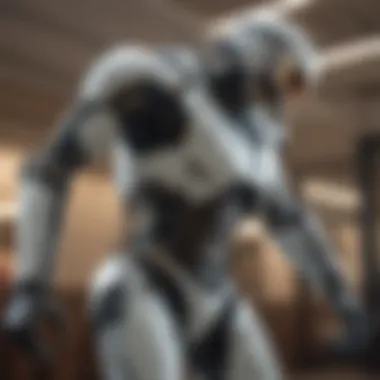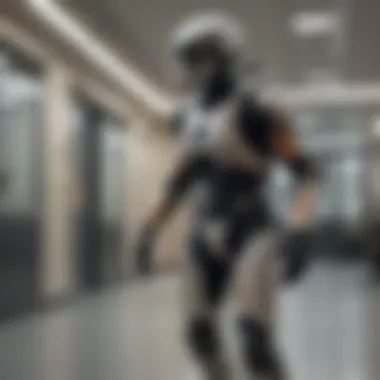Innovative Approaches in Exoskeleton Design


Intro
The exploration of exoskeleton design has gained significant traction in recent years, propelled by advances in technology and increased understanding of biomechanical principles. This article aims to dissect the innovative approaches being employed in the creation of exoskeletons, which promise to transform their applications in various fields.
Exoskeletons are no longer just fanciful machines in science fiction; they are becoming an essential part of rehabilitation, industrial work environments, and even military applications. By merging biomechanics with cutting-edge technology like smart sensors and user-centered design, researchers and designers are pushing the boundaries of what these devices can accomplish.
In this analysis, we will review the context surrounding these innovations, outline key findings, and discuss the potential future paths for exoskeleton technology. Defining the current landscape and its challenges is crucial to illuminate the road ahead.
Prolusion to Exoskeletons
Exoskeletons represent a significant leap in engineering and design, bridging the gap between human capability and machine efficiency. They have garnered growing interest across various sectors, including healthcare, manufacturing, and military applications. This section aims to underscore the vital nature of exoskeleton technology, capturing its implications and potential benefits.
The function of exoskeletons is not merely to provide support but to enhance mobility and reduce fatigue, thereby allowing users to perform tasks that may otherwise be beyond their physical limits. In the context of rehabilitation, exoskeletons assist patients in regaining their mobility, presenting a pathway to recovery that was once thought to be unattainable. Industrial applications benefit similarly, where workers use exoskeletons to alleviate strain and prevent musculoskeletal injuries, which are prevalent in many jobs.
Key Considerations in Exoskeleton Design:
- Mobility enhancement
- Fatigue reduction
- Safety improvements
- Customized applications
Emphasizing user-centered design improves overall functionality according to the specific needs of different users. As we dive deeper into this article, we will explore fundamental concepts that define exoskeletons, along with their significant historical progression.
Defining Exoskeletons
Exoskeletons can be described as wearable machines that augment human motion. These devices are composed of a framework that fits over the user's body, designed to assist with movement and strength. This assistance can either be passive or active, depending on the user's needs.
In the passive mode, exoskeletons rely on mechanical structures, utilizing materials such as springs and struts to support and stabilize the body. In contrast, active exoskeletons integrate motors and sensors for dynamic support, adapting to the user's movements in real-time. This functionality allows for greater versatility, enabling users to execute complex tasks with ease.
Historical Context and Evolution
The journey of exoskeleton technology is rooted in historical innovations that sought to enhance human capabilities. Early concepts date back to the 1960s, with significant prototypes emerging during the mid-20th century. One notable development was the Hardiman suit, which aimed to amplify human strength. Although it faced manufacturing limitations and safety challenges at the time, it laid groundwork for future explorations.
In the decades that followed, advancements in materials science, computer technology, and robotics propelled exoskeletons into new realms. The introduction of lighter materials like carbon fiber and improved motor technologies facilitated the development of more functional devices. Today, exoskeletons are not just a distant prospect; they are integral tools in various fields that promise to reshape how we interact with physical tasks and environments.
"The evolution of exoskeletons is not just a story of technology; it is a testimony to human ingenuity and the quest for enhancement."
The evolution of exoskeletons mirrors societal needs, reflecting an ongoing dialogue between innovation and application. As we proceed through this analysis, the intricate relationship between biomechanics, technology, and user-centered design will unfold, highlighting the sophisticated landscape that exoskeleton development occupies.
Biomechanics of Exoskeleton Design
The field of exoskeleton design cannot be fully understood without delving into biomechanics. This area concerns itself with the study of human anatomy and movement. Recognizing how the human body functions is essential for creating effective exoskeletons that enhance or support physical capabilities. Biomechanics provides insights into the forces acting on the body and informs how exoskeletons can be tailored to minimize user fatigue and optimize performance.
Inclusion of biomechanical principles in design translates into practical benefits. Exoskeletons that align with natural movement patterns reduce the risk of injury. This also creates a more intuitive user experience. The application of biomechanics is not merely academic; it directly impacts the success of exoskeleton technology in real-world scenarios, be it in rehabilitation, industry, or military settings.
Understanding Human Anatomy and Movement
Understanding human anatomy is fundamental to designing effective exoskeletons. The human body comprises complex systems of bones, muscles, and joints that interact in a highly coordinated manner. Each movement involves multiple anatomical parts working together, hence an exoskeleton must replicate these systems to be effective.
There is a need to analyze joint angles, muscle attachment locations, and movement types. Each factor influences how force is applied and distributed. Knowing this allows engineers to design exoskeletons that enhance strength during lifting or provide assistive support in rehabilitation contexts. For example, devices designed for lower limb assistance must carefully consider the knees and ankles to ensure that the user's natural gait is preserved.
Load Distribution and Force Management
Proper load distribution and force management are critical aspects of exoskeleton design. When an exoskeleton is fitted on a user, it must manage forces effectively to reduce stress on both the device and the user. Effective management of external loads not only enhances user comfort but also prolongs the lifespan of the exoskeleton itself.
Exoskeletons must distribute weight evenly across the body to avoid concentrating force at any one point, which could lead to discomfort or injury. Design considerations often include factors such as joint flexibility, materials used, and the overall weight of the device.
Furthermore, engineers must develop smart technologies that monitor and adapt to the user's movements in real-time. This ensures optimal load management and provides feedback that can guide adjustments, ultimately improving safety and performance.


As exoskeleton design continues to evolve, the role of biomechanics remains pivotal in achieving user satisfaction and operational efficiency.
Materials and Manufacturing Techniques
The topic of materials and manufacturing techniques is critical in the discussion of exoskeleton design. The choice of materials not only affects the performance and weight of the exoskeleton but also impacts its durability, cost, and user comfort. Manufacturing processes must be efficient and adaptable to create customized solutions that cater to diverse user needs. Therefore, understanding the interplay between materials and techniques leads to significant advancements in exoskeleton technology.
Innovative Materials for Exoskeleton Construction
Innovative materials play a pivotal role in exoskeleton construction. Traditional materials like steel and aluminum offered strength but often resulted in heavy designs. Modern exoskeletons utilize lightweight composites and advanced polymers, which reduce weight without sacrificing structural integrity. For example, carbon fiber composites are increasingly used because of their high strength-to-weight ratio. This enables the exoskeleton to be more agile, thereby enhancing user mobility.
Another noteworthy development is the use of smart materials that can change properties in response to external stimuli. These materials can adapt their rigidity or flexibility based on the user's movement, thus providing better support and comfort.
Manufacturers are also exploring biocompatible materials for medical exoskeletons. In rehabilitation scenarios, using materials that are soft to touch minimizes skin irritation, improving user compliance during therapy.
3D Printing and Customization
3D printing has emerged as a transformative manufacturing technique for exoskeleton design. This technology allows for rapid prototyping and customization, which is crucial to meet the unique requirements of individual users.
One major benefit of 3D printing is its ability to create complex geometries that are difficult or impossible to achieve with traditional manufacturing methods. This capability enables designers to optimize the exoskeleton's structure for better performance and comfort.
Customization is another advantage. Users often have varying body shapes and sizes, making one-size-fits-all solutions impractical. Through 3D printing, manufacturers can produce exoskeletons tailored to the user's exact dimensions, enhancing fit and utility. The affordability of printing options has also increased accessibility for smaller companies and startups, fostering innovation.
It is essential to note the importance of post-printing treatments to ensure durability and strength. Some 3D-printed materials might require specific treatments to withstand repeated stress and pressure.
In summary, 3D printing and customization are pivotal elements in exoskeleton design. They enable manufacturers to respond quickly to emerging needs and simplify the production of tailored solutions.
Integration of Smart Technology
The incorporation of smart technology into exoskeleton systems has emerged as a defining pillar of modern design and functionality. This integration not only enhances user experiences but also fundamentally transforms the operational capabilities of these devices. Key elements such as advanced sensors, real-time feedback mechanisms, and adaptive control systems facilitate a seamless interaction between the user and the exoskeleton, thus optimizing performance and comfort.
In this rapidly advancing field, several benefits become apparent. Smart technology can significantly improve precision during movements, enabling users to accomplish tasks efficiently. Furthermore, it allows for the collection of valuable data that can inform subsequent design improvements. Additionally, the ability to customize responses based on individual needs broadens the potential applications of exoskeletons dramatically.
Sensors and Feedback Mechanisms
Sensors are vital components in the framework of smart technology applied in exoskeletons. They serve multiple purposes, including the monitoring of user movements, detecting environmental changes, and providing essential data to the control systems. Various types of sensors are employed, such as accelerometers, gyroscopes, and pressure sensors.
By harnessing these devices, exoskeletons can respond to user actions in real time. For example, if a user leans forward, sensors will detect this motion and adjust the exoskeleton's support mechanisms to ensure stability and comfort. The feedback loop created between the sensors and the exoskeleton's actuators is critical for enhanced usability.
"Incorporating sensors within the exoskeleton allows for an intuitive interaction that mimics natural movement, thus elevating the user experience to unprecedented levels."
Adaptive Control Systems
Adaptive control systems represent the next advancement in exoskeleton technology. These systems utilize algorithms to analyze data from sensors and adjust the exoskeleton's functions accordingly. Unlike traditional static systems, adaptive control provides flexibility and responsiveness to various situations.
A significant advantage is the ability to learn from user behavior over time. For instance, if a user has a specific way they walk or move, the adaptive control system can modify the support and resistance offered by the exoskeleton to match this behavior. Additionally, obstacle detection and dynamic repositioning become feasible through these systems, allowing for safer and more efficient navigation in complex environments.
User-Centered Design in Exoskeletons
User-centered design is critical in the sphere of exoskeleton development. This approach directly addresses the users' needs, preferences, and limitations. Focusing on the end-user ensures that the device aligns with the human body and its specific functions. With advances in technology, exoskeletons must not only enhance physical capabilities but also be usable and comfortable.
One essential element of user-centered design is the emphasis on ergonomics. Exoskeletons must fit well, adapt to different body types, and accommodate user movement without imposing additional strain. This means observing the natural motions of individuals and creating exoskeletons that work in harmony with these movements. Good ergonomics contributes to user comfort, reducing fatigue during usage. Designers must thoughtfully consider weight distribution, joint movement, and support during the design phase.
Ergonomics and User Comfort
Ergonomics play a significant role in ensuring that exoskeletons are not only functional but also comfortable for users. Proper ergonomic design minimizes the risk of injury while operating the device. This involves understanding the physical capabilities of users, particularly in rehabilitation settings or industrial applications.
Common strategies in ergonomics include:


- Prioritizing adjustability to cater to a diverse user base.
- Utilizing lightweight materials that do not compromise structural integrity.
- Implementing padded contact points to enhance comfort during prolonged usage.
These aspects create an experience where users feel less restricted or fatigued. Enhanced user comfort leads to increased trust and reliance on the technology, facilitating better rehabilitation outcomes or improved performance in industrial tasks.
Individual Variability and Customization
Individual variability is a significant consideration in user-centered exoskeleton design. Every user has a unique anatomy, making customization a vital aspect. The goal of customization is to create exoskeletons that not only fit the user’s physical dimensions but also cater to unique functional requirements.
To address individual variability, designers can utilize methods such as:
- 3D scanning technologies to create precise models of users’ bodies, ensuring a better fit.
- Adjustable components that allow users to modify settings based on their comfort.
- Collaborating with users during the design stage to gather feedback and insights.
This tailored approach results in devices that feel personal and become an extension of the user's body rather than merely a tool. When users can interact seamlessly with the exoskeleton, their engagement and performance are notably enhanced. As exoskeleton technology advances, incorporating user feedback will continually reshape the customization process, ultimately leading to more effective and user-friendly devices.
Applications of Exoskeleton Technology
The role of exoskeleton technology is expanding rapidly across several domains. The applications extend beyond the realm of science fiction, moving into tangible, real-world utilities. Each application area provides distinct advantages and faces unique challenges. Focusing on rehabilitation, industrial usage, and military advantages highlights the versatility and adaptability of exoskeleton systems.
Rehabilitation and Assistive Devices
Exoskeletons have made significant impacts in rehabilitation. They help individuals with mobility impairments regain movement and functionality. The design of these devices aligns with human biomechanics, facilitating a natural gait. This is crucial for anyone recovering from injuries or managing chronic conditions.
Benefits of using exoskeletons in rehabilitation include:
- Improved Mobility: Patients can stand and walk, promoting muscle strength and joint flexibility.
- Enhanced Motivation: Engaging with a robotic exoskeleton encourages patients to participate in their recovery actively.
- Therapeutic Monitoring: Integrated sensors provide data to therapists, allowing for tailored rehabilitation programs.
Despite these benefits, challenges remain. There is often a high cost associated with advanced rehabilitative exoskeletons. Additionally, the technology must be refined continuously to ensure safety and user comfort.
Industrial and Construction Use Cases
In industrial settings, exoskeletons are increasingly utilized to enhance worker safety and productivity. They reduce physical strain and fatigue while performing heavy lifting and repetitive tasks. This is particularly crucial in sectors like construction, manufacturing, and warehousing.
Key advantages of exoskeletons in industrial applications include:
- Injury Prevention: By assisting with the load, these devices minimize the risk of musculoskeletal injuries.
- Increased Efficiency: Workers can handle more without compromising health, leading to improved output.
- Adaptability: Many designs can address specific tasks, whether lifting, crouching, or overhead work.
However, the integration of exoskeletons into the workplace may face resistance from workers accustomed to traditional methods. Ensuring comfort and user-friendliness while adapting to various tasks is essential.
Military Enhancements and Tactical Applications
In military scenarios, exoskeletons can enhance soldiers' capabilities without sacrificing agility. They serve to augment physical strength, allowing personnel to carry heavier equipment and sustain prolonged missions.
The implications are profound, with benefits including:
- Extended Operational Range: Soldiers can traverse greater distances unencumbered by heavy loads.
- Enhanced Combat Effectiveness: The ability to perform physically demanding tasks increases overall mission success rates.
- Improved Safety: Load management systems reduce the risk of injury during transport or operations.
The military application of exoskeletons also presents difficulties. Development costs and the need for robust field testing can be substantial. Moreover, ethical considerations around the use of such technologies in combat are ongoing discussions.
The efficiency and assistive capabilities of exoskeletons in various sectors highlight their transformative potential.
Challenges in Exoskeleton Development
The topic of challenges in exoskeleton development holds significant weight in the broader discussion of exoskeleton technology. This segment addresses the potential hindrances that designers and engineers face while creating these advanced devices. Exoskeletons, while promising in many respects, are not without their issues. Understanding these challenges is crucial for academics and professionals who are looking to push the boundaries of what these systems can achieve.
Technical Limitations and Safety Concerns


One of the primary obstacles in the development of exoskeletons is inherent technical limitations. These limitations relate directly to the constraints of current technology, such as battery life, weight distribution, and mechanical design. For example, many exoskeletons must balance between providing support and not imposing excessive burdens on the user. Moreover, the mechanical components may experience wear and tear, which can lead to failures in the system.
Safety concerns are closely linked to these technical issues. If an exoskeleton malfunctions during use, it can lead to severe injuries or accidents. The consequences can be especially dire in rehabilitation settings or industrial environments, where users depend on the device to perform critical tasks. Therefore, rigorous testing and adhering to strict safety standards is essential to mitigate risks.
- Battery life limitations affect usability and user confidence.
- Weight distribution challenges can influence user mobility and comfort.
- Mechanical failures due to wear and tear can pose safety risks.
"Innovations in design must prioritize safety while enhancing functionality."
Furthermore, the integration of smart technology into exoskeletons increases complexity. The addition of sensors and control systems enhances performance but also introduces new points of failure. Developers must create a balance between enhancing features and ensuring robust operation without compromising safety.
Cost Implications and Market Dynamics
Costs associated with exoskeleton technology represent another significant challenge. Developing sophisticated exoskeletons requires substantial investment in research, materials, and manufacturing processes. These high upfront costs can deter businesses and consumers alike from adopting or investing in new systems.
Market dynamics also play a role. The demand for exoskeletons is influenced by trends in healthcare, manufacturing, and military applications. As these sectors evolve, so too must the technology. For instance, rehabilitation institutions may have limited budgets, and thus they may only invest in cost-effective solutions. This creates a challenge for comprehensive innovation, as high-quality materials and advanced designs can be prohibitively expensive.
- Research and development costs drive up retail prices.
- Market fragmentation complicates standardization and broad acceptance.
- Budget constraints in healthcare limit the reach of innovative products.
In addition, as more companies enter the exoskeleton market, competition may drive prices down. However, this could lead to compromises in quality. Thus, balancing affordability with maintaining high standards in safety and design becomes a critical challenge for industry players.
Overall, addressing these challenges requires sustained communication and collaboration among engineers, researchers, and manufacturers. Fostering a culture of innovation that prioritizes safety and cost-effectiveness will undoubtedly define the future trajectory of exoskeleton technology.
Future Directions in Exoskeleton Research
The field of exoskeletons is rapidly advancing, and future directions in research promise to refine their design and application further. These advancements represent a pivotal opportunity to enhance user experience and performance. As we look ahead, several specific elements demand attention, including increased collaboration between disciplines, user interaction, and addressing the emerging challenges of integrating these systems into everyday life.
Interdisciplinary Collaboration and Innovation
One significant aspect shaping the future of exoskeleton research is interdisciplinary collaboration. The integration of knowledge from various fields such as biomechanics, robotics, material science, and cognitive psychology is essential. Such collaborations can lead to the creation of more sophisticated devices that meet the complex needs of different users.
For instance, collaboration with medical experts can drive innovations in rehabilitation-focused exoskeletons, while partnerships with industries can yield robust systems for industrial applications. This approach helps to ensure that exoskeletons not only function efficiently but also prioritize user comfort and safety. Here are some benefits of interdisciplinary work in this area:
- Shared Knowledge: Different domains bring unique insights into design and functionality.
- Enhanced Innovation: Collaboration can inspire new concepts leading to innovative designs.
- Broader Applications: Diverse expertise can lead to new uses and adaptations for exoskeleton technology beyond its initial purpose.
"Interdisciplinary collaboration can pave the way for breakthroughs that enhance the effectiveness of exoskeletons across various sectors, highlighting their utility in both clinical and industrial applications."
Prospective Trends in User Interaction
As exoskeletons evolve, focusing on user interaction becomes crucial. Prospective trends in this area may shape how users engage with these devices. Two notable aspects stand out: intuitive control mechanisms and personalization.
Intuitive control systems, such as those relying on brain-computer interfaces or motion capture, can provide users with a more seamless experience. Imagine a scenario where the device responds instinctively to the user’s movements without the need for complex commands. This could enhance usability for individuals in rehabilitation programs or labor-intensive jobs.
Moreover, personalization of exoskeletons is gaining traction. Custom-fit designs can account for individual body mechanics, improving comfort and reducing the risk of injury from prolonged use. Allowing users to customize their devices based on their specific needs, preferences, and body measurements will elevate the overall experience.
To summarize, future directions in exoskeleton research hinge on fostering collaboration across disciplines and thoughtfully considering user interaction. Both avenues are essential for developing effective and practical exoskeleton technologies that can significantly impact various sectors, from healthcare to manufacturing.
Finale and Perspectives
The analysis of exoskeleton design reveals a landscape rich with potential and complexity. Understanding this field is crucial for anyone involved in mechanical engineering, rehabilitation, and assistive technologies. The intersection of innovative materials, biomechanical principles, and smart technology has led to significant advancements. These developments not only enhance the functionality of exoskeletons but also their accessibility across diverse applications.
Key Takeaways from Exoskeleton Design Analysis
- Interdisciplinary Collaboration: This is a cornerstone for the evolution of exoskeleton technologies. Contributions from biomechanics, engineering, and computer science create solutions that are more effective and tailored.
- User-Centered Design: The importance of ergonomics cannot be overstated. Exoskeletons must not only perform effectively but also ensure user comfort and adaptability.
- Smart Integration: Sensors and adaptive control systems are transforming how users interact with exoskeletons. The feedback mechanisms improve efficiency and safety, making wearers more confident in their use.
- Challenges: Development of these advanced systems comes with obstacles, including cost and regulatory challenges. Addressing these issues is essential for widespread adoption.
The Road Ahead for Exoskeleton Technologies
Future research and development in exoeSkeletons present exciting possibilities. Here are a few directions worth noting:
- Sustainability in Materials: There is an increasing focus on using environmentally friendly materials and processes in exoskeleton manufacturing. This could reduce ecological impact and production costs.
- Enhanced User Experience: Continued advancements in the user interfaces and control systems can lead to seamless interaction. This would result in better outcomes for rehabilitation and mobility.
- Broader Applications: Expanding the use of exoskeletons beyond rehabilitation into areas like elder care and sports. Tailored solutions for diverse demographics could improve quality of life significantly.
"The future of exoskeleton technologies hinges on our capacity to innovate and adapt, ensuring they meet the evolving needs of society."
In summary, the field of exoskeleton design is not static; it continues to evolve through collaboration and technological advancements. As challenges are met with innovative solutions, the potential for exoskeletons to transform human life grows immensely.







